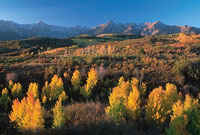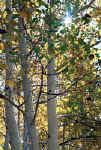SHOOTING FALL COLORS
MIDWEST’S FALL GEMS
An Article By Abhi Ganju
(Give Abhi’s article some thought and it may help you make better Fall images. LB)


If leaves were born red, fall would be a non-event. Fall drama comes from change – a 180 degree change in several ways: from green to red, opposites on the color wheel; from a cool to a warm shade; and from background to main subject. Foliage, previously a dutiful backdrop for more attractive florals, boldly reverses roles and demands center stage with its brilliance and novelty.
The autumn sun shines from a lower angle, changing the quality of light. Clear blue sky replaces summer’s dirty haze. Fluffy white clouds sail in, further enhancing the reds, oranges and yellows of autumn. And color isn’t the only subject. Patterns abound in leaves. Early morning frost and fog add texture and mood. Nature, in the fall, gifts everything on the summer weary photographer’s wish list. And we haven’t even got to reflections yet. Those will add yet another level of richness.
So get the Velvia out of the fridge and pack every lens you’ve got. And don’t forget your gloves.


Day one: stand before the red maple and click. Zoom in on a few leaves, click. Aim upward and shoot leaves against blue sky. Then shoot some backlit leaves.
Now you are done with the clichés.
Get ready for some creative image making. Several strategies can elevate your images from simply “nice” to extraordinary. One is to go to the photo spots over and over, getting slides processed daily and reviewing them nightly. This gives you a chance to improve on images and redo any errors.
To intensify reds and oranges, use that natural enhancer, the morning sun. Contrasted against blue sky, reds will appear even redder. Polarize to saturate foliage and deepen the sky. Spot meter on the deep red leaves and underexpose by one stop.
Fall photos change from year to year – you cannot duplicate last year’s images. In Illinois’ Mathiessen State Park this year the canyon floor was flooded and I could not walk beyond a 50 foot area. This turned out to be a blessing in disguise, for it forced me to look closer. And I struck gold. The most amazing gold and copper colors were reflected in the water, bordered by rocks and strewn with red leaves.
First I took some wide angle shots encompassing the canyon walls, rocks and water, with trees rising up the center. Using my 28mm lens at f16, I set the hyperfocal distance at 7 feet, spot metered on a gray card and bracketed by 2/3rd stop on both sides.
Then I took the camera off the tripod and moved around, looking through the viewfinder from various angles and varying focal lengths. Each time different compositions presented themselves, and new metallic reflections appeared. For better composition, I gently moved some of the leaves on the water’s surface. At 100mm focal length and f8, I framed three rocks, with leaves floating diagonally across the frame. I looked for S-shaped patterns and shot some vertical as well as horizontal frames.
Then, at 300mm and f5.6, I zoomed on a small group of leaves that lay on green reflection. Surrounded by pine needles and blue bubbles, they made interesting patterns whose jewel-like quality immediately suggested a title – “fallen gems.” I metered on the rocks, and, judging them to be darker than a gray card, I underexposed by 2/3rd stop and used that as my middle exposure. Then I shot at 2/3rd stop over as well as under the middle exposure. I focused about a third of the way into the image. Moving around, I framed some red leaves floating on the sky’s blue reflection.
Remember, don’t walk away because there seems to be nothing to shoot. Follow Lonnie Brock’s advice. Just stay and “work” a spot and you will be rewarded with one-of-a-kind images.
Abhi shoots a Nikon N90s, with many of the images here made with the Nikkor 70-300mm f/4-5.6D lens on a Bogen tripod.
